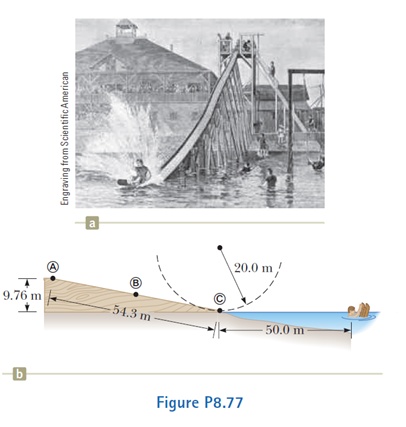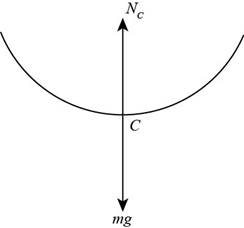
Concept explainers
Review. In 1887 in Bridgeport, Connecticut, C. J. Belknap built the water slide shown in Figure P8.77. A rider on a small sled, of total mass 80.0 kg, pushed off to start at the top of the slide (point Ⓐ) with a speed of 2.50 m/s. The chute was 9.76 m high at the top and 543 m long. Along its length, 72.5 small wheels made friction negligible. Upon leaving the chute horizon-tally at its bottom end (point ©), the rider skimmed across the water of Long Island Sound for as much as 50 m, “skipping along like a flat pebble,” before at last coming to rest and swimming ashore, pulling his sled after him. (a) Find the speed of the sled and rider at point © (b) Model the force of water friction as a constant retarding force acting on a particle. Find the magnitude of the

(a)
The speed of the sled and rider at point
Answer to Problem 8.77AP
The speed of the sled and rider at point
Explanation of Solution
Given info: The speed at point
The formula to calculate the kinetic energy at point
Here,
The formula to calculate the initial gravitational potential energy at point
Here,
The formula to calculate the gravitational potential energy at point
Here,
The formula to calculate the kinetic energy at point
Here,
The formula to calculate the energy at point
Here,
Substitute
The formula to calculate the energy at point
Here,
Substitute
Apply the law of conservation of energy at point
Here,
Substitute
Rearrange the above formula for
Substitute
Take the approximation.
Conclusion:
Therefore, the speed of the sled and rider at point
(b)
The magnitude of the friction force the water exerts on the sled.
Answer to Problem 8.77AP
The magnitude of the friction force the water exerts on the sled is
Explanation of Solution
Given info: The speed at point
The free body diagram is shown below.

Figure II
The formula to calculate the work done by the friction force at point
Here,
The formula to calculate the energy at point
Here,
Substitute
The formula to calculate the energy at point
Here,
Substitute
Apply the law of conservation of energy at point
Here,
Substitute
Rearrange the above formula for
Substitute
Thus, the value of work done by the frictional force is
From the above figure, the displacement is
Substitute
Thus, the frictional force acts on point
The formula to calculate the normal force is,
Here,
Substitute
Thus, the value of normal force is
The formula to calculate the magnitude of the force the water exerts on the sled is,
Here,
Substitute
Conclusion:
Therefore, the magnitude of the friction force the water exerts on the sled is
(c)
The magnitude of the force the chute exerts on the sled at point
Answer to Problem 8.77AP
The magnitude of the force the chute exerts on the sled at point
Explanation of Solution
Given info: The speed at point
From the above figure,
The formula to calculate the force exerted by the weight of the chute is,
Here,
The formula to calculate the force acting at point
Here,
The acceleration is 0 at point
The formula to calculate the force at the point
Here,
Substitute
Substitute
Conclusion:
Therefore, the magnitude of the force the chute exerts on the sled at point
(c)
The magnitude of the force the chute exerts on the sled at point
Answer to Problem 8.77AP
The magnitude of the force the chute exerts on the sled at point
Explanation of Solution
Given info: The speed at point
From the above figure,
The formula to calculate the centripetal force exerted at point
Here,
The formula to calculate the weight of chute at point
Here,
The formula to calculate the force at the point
Here,
Substitute
Substitute
Conclusion:
Therefore, the magnitude of the force the chute exerts on the sled at point
Want to see more full solutions like this?
Chapter 8 Solutions
Physics For Scientists And Engineers, Volume 2, Technology Update
- The puck in Figure 10.25 has a mass of 0.120 kg. The distance of the puck from the center of rotation is originally 40.0 cm, and the puck is sliding with a speed of 80.0 cm/s. The string is pulled downward 15.0 cm through the hole in the frictionless table. Determine the work done on the puck. (Suggestion: Consider the change of kinetic energy.)arrow_forwardA small block of mass m = 200 g is released from rest at point along the horizontal diameter on the inside of a frictionless, hemispherical bowl of radius R = 30.0 cm (Fig. P7.45). Calculate (a) the gravitational potential energy of the block-Earth system when the block is at point relative to point . (b) the kinetic energy of the block at point , (c) its speed at point , and (d) its kinetic energy and the potential energy when the block is at point . Figure P7.45 Problems 45 and 46.arrow_forwardA space probe is fired as a projectile from the Earths surface with an initial speed of 2.00 104 m/s. What will its speed be when it is very far from the Earth? Ignore atmospheric friction and the rotation of the Earth. P11.26 Ki+Ui=Kf+Uf12mvi2+GMEm(1rf1ri)=12mvf212vi2+GME(01RE)=12vf2orvf2=v122GMEREandvf=(v122GMERE)1/2,vf=[(2.00104)21.25108]1/2m/s=1.66104m/sarrow_forward
- To develop muscle tone, a woman lifts a 2.00-kg weight held in her hand. She uses her biceps muscle to flex the lower arm through an angle of 60.0°. (a) What is the angular acceleration if the weight is 24.0 cm from the elbow joint, her forearm has a moment of inertia of 0.250kg-m2 and the net force she exerts is 750 N at an effective perpendicular lever arm of 2.00 cm? (b) How much work does she do?arrow_forwardA giant swing at an amusement park consists of a 365-kg uniform arm 10.0 m long, with two seats of negligible mass connected at the lower end of the arm (Fig. P8.53). (a) How far from the upper end is the center of mass of the arm? (b) The gravitational potential energy of the arm is the same as if all its mass were concentrated at the center of mass. If the arm is raised through a 45.0 angle, find the gravitational potential energy, where the zero level is taken to be 10.0 m below the axis, (c) The arm drops from rest from the position described in part (b). Find the gravitational potential energy of the system when it reaches the vertical orientation. (d) Find the speed of the seats at the bottom of the swing.arrow_forwardTo develop muscle tone, a woman lifts a 3.70 kg mass held in her hand. She uses her biceps muscle to flex the lower arm through an angle of 60.0°. Ignore gravity. (a) What is the angular acceleration if the mass is 24.0 cm from the elbow joint, her forearm having a moment of inertia of 0.250 kg · m2, and the muscle force being 760 N at an effective perpendicular lever arm of 2.50 cm? (b) How much work does she do?arrow_forward
- You are testing a new amusement park roller coaster with an empty car of mass 120 kg. One part of the track is a vertical loop with radius 12.0 m. At the bottom of the loop (point A) the car has speed 25.0 m/s, and at the top of the loop (point B) it has speed 8.0 m/s. As the car rolls from point A to point B, how much work is done by friction?arrow_forwardIn a basketball game, lebron made a dunk. At the time he was hanging on to the rim, the rim was displaced 15cm and he was 1.5m above the floor. Let us say that lebron has a point mass of 110 kilograms, and the force constant of the rim is 7 kN/m what is his total potential energy while he is hanging on the rim? A. 79 J B. 80 J C. 2405 J D. 1617 J E. 1696 Jarrow_forwardA gardener pushes a 11 kg lawnmower whose handle is tilted up 37∘above horizontal. The lawnmower's coefficient of rolling friction is 0.20. How much power does the gardener have to supply to push the lawnmower at a constant speed of 1.4 m/s? Assume his push is parallel to the handle.arrow_forward
- A small block of mass M = 300 g begins at height Y1 above the ground. It slides down a frictionless surface and encounters a loop of radius R = 4 m, as shown in the figure , what should be the height of release so that the block would make it on the loop with out fall off. A. 10 m B. 12m C. 8m D. 5m E. None of the abovearrow_forwardWhen a 78.0 kg skateboarded passes point P, his mechanical energy is 3.68 x 10^3 J relative to the ground.When he passes point Q he is moving at 8.15 m/s. How high is the skateboarder (relative to the ground) at point Q? Assume that the skateboard rolls with negligible friction.arrow_forwardA roller-coaster car shown in Figure P8.72 is released from rest from a height h and then mows freely with negligible friction. The roller-coaster track includes a circular loop of radius R in a senical plane. (a) First suppose theca: barely makes in around the loop: at the top of the loop. the riders are upside down and feel weightless. Find the required height hof the release point above the bottom of the loop in terns d R (b) Now assume the release point is at or above the minimum required height. Show that the normal force on the car at the bottom of the loop exceeds the nor-mal force at the top of the loop by six times thecars weight. The normal force un each rider follows the same rule. Such a large normal forte is dangerous and very uncomfortable for the riders. Roller coasters are therefore not built with circular loops in vertical planes. Figure P6.17 (page 170) shows an actual design.arrow_forward
 Principles of Physics: A Calculus-Based TextPhysicsISBN:9781133104261Author:Raymond A. Serway, John W. JewettPublisher:Cengage Learning
Principles of Physics: A Calculus-Based TextPhysicsISBN:9781133104261Author:Raymond A. Serway, John W. JewettPublisher:Cengage Learning College PhysicsPhysicsISBN:9781285737027Author:Raymond A. Serway, Chris VuillePublisher:Cengage Learning
College PhysicsPhysicsISBN:9781285737027Author:Raymond A. Serway, Chris VuillePublisher:Cengage Learning College PhysicsPhysicsISBN:9781938168000Author:Paul Peter Urone, Roger HinrichsPublisher:OpenStax College
College PhysicsPhysicsISBN:9781938168000Author:Paul Peter Urone, Roger HinrichsPublisher:OpenStax College


